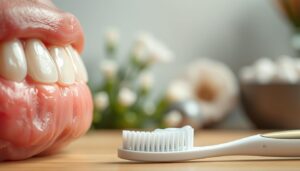Gum problems are often overlooked in the early stages, yet they can lead to severe consequences if left untreated. Early diagnosis of gum issues is crucial for maintaining overall oral health, as untreated gum disease can result in tooth loss, infection, and other serious health complications. Recognizing the early signs of gum disease allows for timely intervention, preventing more invasive treatments down the line and preserving the integrity of your smile.
Gum problems typically start subtly, with symptoms like slight bleeding, redness, or swelling. These early indicators can be easily dismissed, but when ignored, they can progress into more advanced stages, such as periodontitis, which can lead to irreversible damage to the gums and supporting structures of the teeth. The key to avoiding these complications is early detection through regular dental check-ups, proper oral hygiene practices, and being aware of the warning signs your gums may give.
In this article, we will explore the importance of early diagnosis for gum problems, how to identify the first signs of gum disease, and the role regular dental visits play in preserving your gum health. By understanding the significance of early intervention, you can take proactive steps to protect your smile and ensure long-term oral health.
Gum health is an essential but often neglected aspect of overall oral care. While we tend to focus on brushing and flossing for maintaining clean teeth, the health of the gums plays a vital role in preventing a range of dental and systemic health issues. From gum inflammation to more severe conditions like periodontal disease, the condition of your gums can significantly affect your oral hygiene and quality of life. However, many people don’t realize that gum problems can develop silently, showing few signs until they become more serious and harder to treat.
The earlier gum issues are identified, the easier they are to manage and the less likely they are to cause long-term damage. Gum disease doesn’t only affect the mouth—it has been linked to various other health concerns, such as heart disease, diabetes, and respiratory issues. Therefore, understanding the signs and symptoms of gum problems early on is crucial in preventing a cascade of potential health risks. In this article, we will delve into the early warning signs of gum disease, why early intervention is key to preserving your oral health, and how regular dental visits and proper oral care can keep your gums healthy and strong.
What Are Gum Problems and How Do They Affect Health?
Gum problems, commonly referred to as periodontal disease, are a group of conditions affecting the tissues surrounding and supporting the teeth. They start with inflammation of the gums (gingivitis) and, if left untreated, can progress to more severe forms, such as periodontitis, which can damage the underlying bone and lead to tooth loss. Gum problems are not only a concern for oral health, but they can also impact overall health. Research has shown that untreated gum disease can contribute to heart disease, diabetes, respiratory issues, and complications during pregnancy. Therefore, preventing and diagnosing gum issues early is vital for both oral and systemic health.
Key Symptoms Indicating Gum Problems
There are several key symptoms to watch for when it comes to gum problems. These include:
- Bleeding Gums: This is one of the first signs of gum inflammation. If your gums bleed during brushing or flossing, it could be an indication of gingivitis, the early stage of gum disease.
- Redness or Swelling: Healthy gums should appear pale pink and firm. If your gums are red, swollen, or tender, it might indicate an inflammatory response, a common sign of gum disease.
- Bad Breath (Halitosis): Persistent bad breath, also known as halitosis, can be caused by bacteria that accumulate in the pockets of infected gums.
- Receding Gums: As gum disease progresses, the gums may start to pull away from the teeth, creating pockets where bacteria can thrive.
- Loose Teeth: In more advanced stages of gum disease, the support structure of the teeth weakens, which can cause teeth to loosen.
If you notice any of these symptoms, it’s crucial to take action quickly before the condition worsens.
How to Identify Signs of Gum Disease in the Early Stages
Identifying gum disease in its earliest stages can prevent its progression. Early signs include:
- Slight Bleeding: Gum bleeding, especially when brushing or flossing, is often the first symptom of gingivitis.
- Discomfort: You may notice gum tenderness or soreness, especially while eating or brushing.
- Changes in Gum Color: Healthy gums are pink. Red or purple gums may indicate infection or inflammation.
- Bad Taste or Bad Breath: Foul-smelling breath that persists despite good oral hygiene can be a sign of gum infection.
By being vigilant about these subtle signs, you can take early action to avoid more serious gum problems.
Professional Examinations: How Dentists Diagnose Early Gum Problems
Dentists play a key role in the early diagnosis of gum problems. During regular dental check-ups, they will perform a thorough examination of your gums, looking for signs of inflammation, infection, and the presence of plaque or tartar buildup. They may use specialized tools to measure the depth of any gum pockets (the spaces between your gums and teeth) to determine the extent of the disease. X-rays may also be taken to check for bone loss in more severe cases. Early detection by a dentist can help ensure prompt treatment, preventing long-term damage.
The Contribution of Oral Hygiene in Early Diagnosis of Gum Problems
Good oral hygiene practices are essential not only for preventing gum disease but also for identifying it early. Brushing your teeth twice a day with fluoride toothpaste and flossing daily helps remove plaque and food particles from the gums. Regular self-examination of your gums—looking for signs of swelling, bleeding, or changes in texture—can help you catch problems before they progress. Using an antimicrobial mouthwash can also reduce bacteria that contribute to gum inflammation. When combined with professional care, these habits help keep gum issues at bay and allow for early detection.
Risk Factors for Gum Problems and Their Relationship to Early Diagnosis
Certain factors can increase your risk of developing gum disease, including:
- Smoking and Tobacco Use: Tobacco use significantly increases the risk of gum disease, as it weakens the immune system and reduces blood flow to the gums.
- Poor Diet: A diet low in vitamins and minerals, especially vitamin C, can impair gum health and increase susceptibility to infections.
- Medical Conditions: Diseases such as diabetes, cardiovascular disease, and autoimmune disorders can make you more prone to gum problems.
- Medications: Some medications can cause dry mouth, which reduces the saliva that helps protect gums from infection.
- Genetics: A family history of gum disease can predispose you to developing it.
If you are at higher risk, it is even more important to stay vigilant and undergo regular dental check-ups to ensure early diagnosis.
The Importance of Regular Dental Visits for Early Detection
Regular dental visits are essential in the early detection and prevention of gum problems. Dentists can spot early signs of gum disease that may not be immediately noticeable to you. Professional cleaning removes plaque and tartar that brushing and flossing cannot, reducing the risk of gum infection. In addition, your dentist can provide advice on oral hygiene habits tailored to your specific needs, helping you keep your gums healthy. Visiting the dentist at least twice a year is a proactive step toward preventing serious gum issues and maintaining optimal oral health.
By incorporating early detection practices, maintaining good oral hygiene, and scheduling regular dental check-ups, you can significantly reduce the risk of severe gum disease and ensure the long-term health of your gums and teeth.
How to Maintain Gum Health and Prevent Problems in the Future
Maintaining healthy gums is a cornerstone of good oral hygiene and overall health. By adopting proactive habits, you can significantly reduce the risk of gum problems and ensure your gums stay strong and disease-free. Early detection of gum issues is key to preventing more severe complications, such as tooth loss and systemic health problems. Here’s how you can protect your gum health and avoid future issues:
- Practice Consistent Oral Hygiene: Brushing your teeth at least twice a day with fluoride toothpaste and flossing daily are essential steps in preventing plaque buildup, which can lead to gum disease. Regular brushing helps remove food particles and plaque from the teeth and gums, while flossing ensures that the areas between the teeth are properly cleaned.
- Use the Right Tools: Choose a soft-bristled toothbrush to avoid damaging your gums, and consider using an antimicrobial mouthwash to reduce bacteria that cause gum infections. An electric toothbrush can also be effective in providing a deeper clean, particularly for people who may have difficulty brushing properly.
- Stay Hydrated: Drinking plenty of water throughout the day helps maintain saliva production, which is essential for neutralizing acids in the mouth and washing away food particles. A dry mouth can lead to an increased risk of gum disease, so staying hydrated is crucial.
- Eat a Balanced Diet: A nutrient-rich diet plays an important role in gum health. Foods high in vitamins C and D, such as citrus fruits, leafy greens, and fatty fish, help support gum tissue and prevent inflammation. Avoid excessive sugary or acidic foods, as they can contribute to plaque buildup and gum irritation.
- Avoid Tobacco: Smoking and other forms of tobacco use significantly increase the risk of gum disease by weakening the immune system and reducing blood flow to the gums. Quitting smoking or using tobacco products can have a profound positive impact on your gum health.
- Visit the Dentist Regularly: Routine dental check-ups are essential for catching gum problems early and ensuring your gums remain healthy. Dentists can perform professional cleanings, assess gum health, and provide advice tailored to your needs. Regular visits also allow your dentist to detect early signs of gum disease before they progress into more severe stages.
- Manage Health Conditions: Conditions like diabetes, heart disease, and autoimmune disorders can increase your susceptibility to gum problems. If you have any underlying health conditions, managing them effectively with the help of your healthcare provider can reduce the risk of developing gum disease.
By incorporating these preventive measures into your daily routine, you can maintain healthy gums and avoid future problems. Early intervention and consistent care are the best strategies for preserving not only your gum health but your overall well-being. Remember, your gums play a critical role in supporting your teeth and overall oral health—taking care of them today ensures a healthier, brighter smile tomorrow.
In conclusion, prioritizing gum health is essential for maintaining a healthy smile and overall well-being. By integrating simple yet effective practices into your daily routine, such as consistent oral hygiene, proper nutrition, and regular dental visits, you can significantly reduce the risk of gum disease and its associated complications. Early detection and intervention are crucial for preventing more severe conditions, including tooth loss and systemic health issues. Additionally, adopting a holistic approach to your health, such as managing chronic conditions and avoiding tobacco, can further protect your gums and improve your quality of life.
Remember, healthy gums are not just about preventing disease; they are key to supporting your teeth, your smile, and your overall health. By taking proactive steps today, you are investing in a lifetime of good oral health and a future free from the burden of gum problems. Stay committed to your gum care routine, and you’ll enjoy the long-term benefits of a strong, healthy smile.




